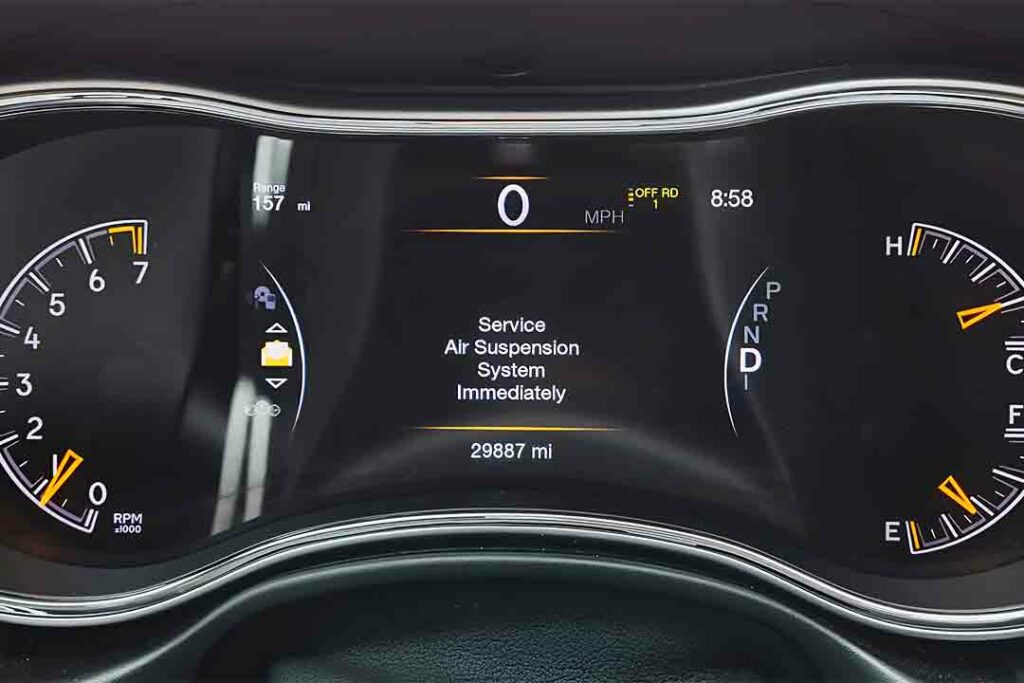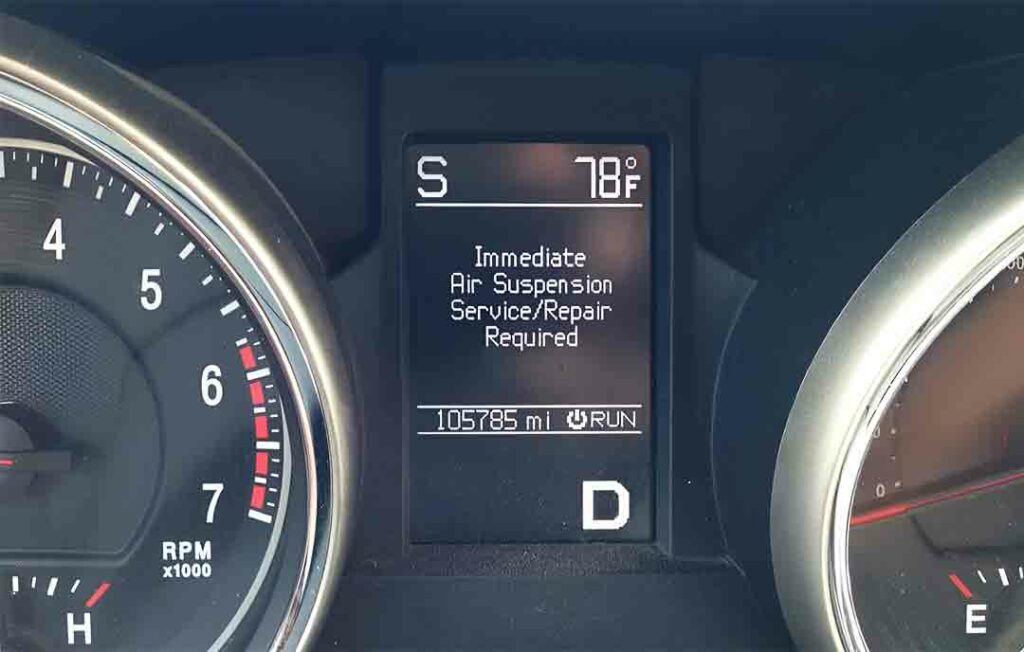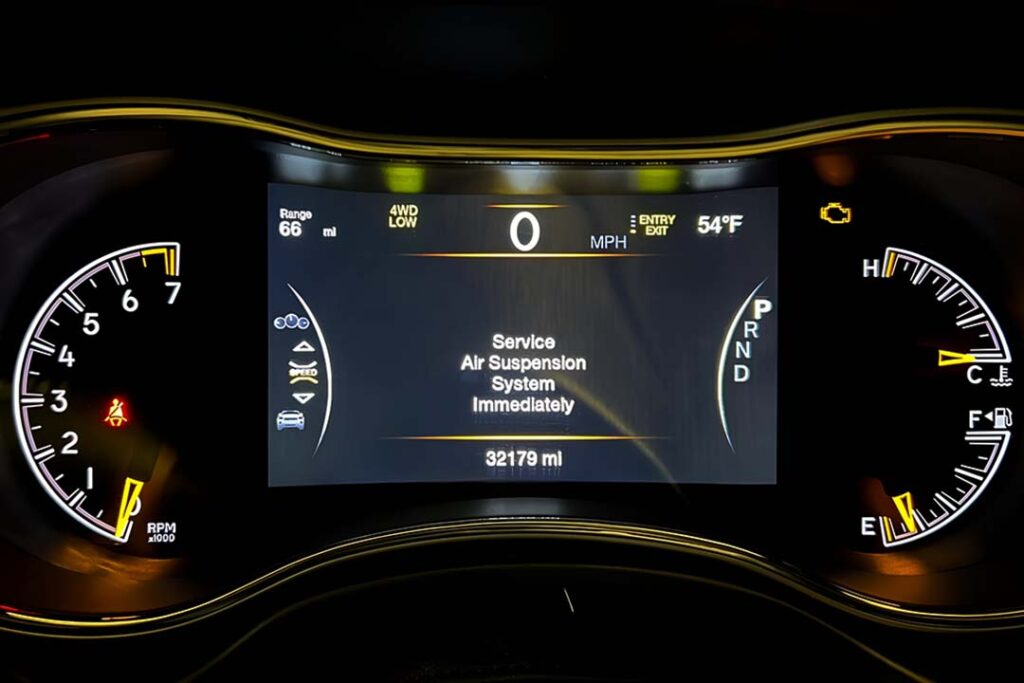Service Air Suspension System Immediately: How To Fix The Warning?
The air suspension system ensures a smooth and comfortable ride for your Jeep. However, you’ll see the Service Air Suspension System Immediately warning sooner or later. It’s essential to address the situation promptly.
The Service Air Suspension System Immediately issue can appear for many reasons, such as a weak 12V battery, air spring leaks, malfunctioning compressors, sensor inaccuracies, wiring problems, control module glitches, excessive weight, moisture corrosion, rubbing airlines, extended inactivity, leaking Quadra-Lift suspension, and cold weather-related complications. These issues disrupt the system’s function.

To address the Service Air Suspension System Immediately problem, you can perform a bounce test, reset the system, use an OBD scanner for diagnostics, test the battery, replace damaged air springs or struts, address air valve issues, replace the compressor, fix faulty sensors, resolve wiring problems, repair or replace the control module, avoid overloading, clean moisture-related corrosion, locate and fix air leaks, and address Quadra-Lift suspension leaks. These actions will restore proper suspension function.
Rest assured that you’re not alone if you’re facing suspension concerns. I’ll guide you through common causes of Jeep suspension problems, including the Service Air Suspension Immediately warning and the steps you can take to resolve them.
Table of Contents
What Is Air Suspension?
Before we go into how to deal with the Immediate Air Suspension Service Required warning, let’s learn about air suspension and understand how it works.
The air suspension system is an upgraded version of the regular suspension. It is designed to provide a smoother and more comfortable driving experience.
Air suspension works in a different way than regular suspension. Instead of the usual coil springs made of steel, air suspension uses air-filled rubber bags known as air springs to absorb the road bumps and vibrations to give you a smooth ride. These air springs work with other components like an air compressor, height and air pressure sensors, and an air reservoir.
A control module monitors every air spring that has its air pressure. If the pressure decreases, the air is sent to that specific spring, lifting your vehicle’s height. On the other hand, if the pressure becomes too high, a release valve lets out some air, maintaining that ideal balance. It has many advantages, like a comfortable ride on rough terrain, improved handling, and enhanced durability.
Even when you haul a bunch of stuff in the back of your vehicle, the air suspension ensures your Jeep maintains the perfect height for driving.
The Jeep Grand Cherokee has a unique air suspension. Thanks to its quadra-lift system, it offers adjustable Jeep height for different driving conditions without even requiring you to stop the Jeep.
Like anything technical, air suspension systems have their issues. They are costlier to maintain due to their complexity. They can become vulnerable if you don’t maintain them,
So, now you know about the air suspension systems, especially the one in the Jeep Grand Cherokee. Let’s discuss what it means when you see the Jeep Grand Cherokee or Jeep Wagoneer Service Air Suspension System Immediately warning.
What Does the Service Air Suspension System Immediately Mean?
When your Jeep’s air suspension system encounters problems, it warns you through messages or lights. For instance, you may see Service Air Suspension Immediately in your Jeep Grand Cherokee. But what exactly does this message mean, and why does your Jeep say Service Air Suspension System Immediately?
As your Jeep gets older, air suspension problems become more frequent, especially the 2011 and 2012 Grand Cherokees are more susceptible to these issues. The dreaded Immediate Air Suspension Service/Repair Required Jeep warning is a telltale sign of trouble. Sometimes the message doesn’t appear or disappears after a while, but you can still sense that something’s wrong with your air suspension system. You may notice your Jeep is lower at the front, it doesn’t handle smoothly, or you can see uneven wear on the tires. These are all signs that something’s off.
Your mechanics’ first guess may be a leaking air compressor, leading to an insufficient air supply. However, it’s not just the air compressor that can be causing the issue. Internal components like the airbag, lines, and links can cause the problem. Your Jeep’s height sensor takes information all the time, detecting irregularities in the air suspension system and promptly relaying the message to you through the Service Air Suspension System Immediately Jeep Grand Cherokee warning alert.

You’ll notice that the Service Air Suspension System Immediately warning isn’t bound to just one type of Jeep – whether you’re driving a 2018 Jeep Grand Cherokee or a Jeep Wagoneer, the issue is present. But it is most frequent in 2011, 2012, 2014, 2017, 2018, and 2019 Jeep Grand Cherokee
Overland models.
Now, I will delve into the specific reasons for the Service Air Suspension System Immediately Jeep Grand Cherokee warning and explore the common signs of a bad air suspension system. I will also walk you through how to resolve these problems. So, hang in there!
The Reasons Jeep Says Service Air Suspension System Immediately
Many factors can trigger the Service Air Suspension System Immediately error in a Jeep. Understanding these factors allows you to diagnose and address the issues effectively. Go through the list to pinpoint the exact cause.
Weak 12V Battery
A faulty or failing 12V battery can interfere with the proper operation of the air suspension system. The system needs consistent and sufficient power to operate. If the battery can’t provide adequate power, it can lead to malfunctions and trigger the Service Air Suspension System Immediately warning message.
Leaking or Damaged Air Springs
Air springs, also known as airbags, can develop leaks or get damaged over time. This results in air pressure loss. This loss causes an imbalance within the suspension system and triggers the Service Air Suspension System Immediately warning messages. Leaking air springs may lead to uneven ride height and poor suspension performance. It also puts pressure on the air compressor, causing it to malfunction prematurely.
Air Compressor Failure
The air springs receive compressed air from the air compressor. There may be insufficient air pressure if the compressor does not work correctly. Which causes the air suspension to behave abnormally and triggers the Immediate Air Suspension Service Required Jeep warning message.
Faulty Sensors
The air suspension system depends on sensors to monitor ride height, load, and road conditions. If you have malfunctioning sensors, they can transmit inaccurate data to the control module. In that case, incorrect adjustments may happen, and the Service Air Suspension System Immediately warning message may be triggered.
Wiring or Electrical Issues
Faulty wiring, loose connections, or electrical problems within your air suspension system can disrupt communication between components. This disruption can lead to improper system operation, and the Service Air Suspension System Immediately warning message can appear.
Control Module Malfunction
The control module acts as the brain of your air suspension system. It manages communication between components and instructs them to make adjustments. A malfunctioning control module can cause erratic system behavior and trigger the Service Air Suspension System Immediately warning message.
Excessive Weight
Overloading your Jeep or carrying excessive weight than its recommended capacity can strain the air suspension system. Excessive strain may cause premature wear and tear. It affects the suspension performance and prompts the Service Air Suspension System Immediately warning message.
Moisture and Corrosion
Often, malfunctioning air dryers and filters can cause moisture to enter the system. Moisture can lead to corrosion and rust within your suspension components. Corroded parts can disrupt system functionality and trigger warning messages.
Rubbing Air Lines
Sometimes air lines rub against other parts during suspension movement. Rubbing can cause air leaks and sagging of the suspension. This loss of air pressure and abnormal suspension behavior trigger warning messages.
Extended Inactivity
If you don’t drive your Jeep for extended periods, especially in cold weather conditions, your suspension components can get stuck or experience reduced functionality. It results in the Service Air Suspension System Immediately warning message as the system struggles to operate appropriately.
Leaking Quadra-Lift Suspension
In Jeep Grand Cherokees equipped with quadra-lift suspension, leaks in the system can cause uneven ride height. The front of your Jeep gets lower than intended or gets stuck in a specific position.
Cold Weather-Related Issues
Cold weather can exacerbate existing problems within your air suspension system. During cold weather, moisture freezing within the air compressor can damage solenoids and valves. It affects air compression and suspension performance.
Cold and damp conditions can weaken your Jeep’s electrical system. It can cause the air compressor to work harder, potentially leading to premature failure and the Service Air Suspension Immediately warning message.
You need to address these issues quickly to prevent further air suspension damage and stop the warning messages from appearing.

How Do You Fix Service Air Suspension Immediately Issue?
Usually, the air suspension problems are similar for everyone. The issues may seem complex, but they are easy to fix. Sometimes they can be pretty expensive. The air suspension in the Jeep Grand Cherokee is much more complex and thus requires more attention and costs more.
1. Perform a Bounce Test
Perform a straightforward bounce test to isolate suspension issues. Park your Jeep on a level surface. Turn off the engine and push down each corner of the Jeep Grand Cherokee. Observe the rebound. A stable bounce indicates your suspension is fine. While excessive or delayed bounce points to suspension issues.
With some visual inspection, if you confirm there are no leaks and obvious faults, your first step is resetting the air suspension system. It’ll resolve any minor issues or software glitches.
2. Reset Air Suspension System
Disconnect Battery Cables
First, disconnect both the positive and negative battery cables of your Jeep. Keep them disconnected for 5-10 minutes to ensure a complete reset.
Disconnect Fuses
Disconnect the following fuses in the fuse panel:
- F05: Air Suspension Compressor
- F50: Air Suspension Mod
- F87: Air Suspension/TT
You can find the fuse panel on the passenger side near the instrument panel. Lift the panel cover to access the fuses.
Reconnect
Now, reconnect all the fuses that you have disconnected. After that, reconnect the battery cables. Wait for 8-10 minutes after you have reconnected everything.
Test
Start your Jeep after reconnecting everything. Check if the lift system has returned to the proper height. If you have done a Jeep Grand Cherokee air suspension reset, verify the functionality of the quadra-lift system by adjusting the ride height. If the issue continues and the warning reappears, there’s an underlying problem. However, the reset may have solved the case if the error message disappears.
3. False Warning in Cold Weather
Sometimes, Jeeps, especially the Grand Cherokee, display false warning messages about the air suspension system. It happens frequently during cold weather. If you encounter this situation, follow the steps above about the Jeep Grand Cherokee air suspension reset. If these warnings persist, you need to take your Jeep to your dealership to investigate further.
4. Diagnose Issues With an OBD Scanner
An OBD (On-Board Diagnostics) scanner allows you to tap into your Jeep’s on-board computer system. It lets you access the diagnostic trouble codes (DTCs) linked to various components, including the air suspension system. It enables you to quickly find out the exact issue.
- Get an OBD scanner compatible with your specific Jeep model. Choose one with a handheld device or smartphone app with Bluetooth or Wi-Fi connectivity.
- The OBD-II port is usually under the driver’s side dashboard. Some ports have a cover. Remove the cover to access the port.
- Carefully insert the scanner’s connector into the port. Ensure it’s connected securely.
- Switch on the scanner. Follow the manual to connect with your Jeep’s computer system.
- Using the scanner’s menu, access the function for getting DTCs. The scanner will gather stored DTCs.
- Record the DTCs from the scanner’s screen. Each code relates to a specific problem. You need the DTCs that are relevant to the air suspension system. Use the scanner’s user manual or Google them to understand the DTCs’ meaning and the underlying issue.
- Once you have the decoded DTCs, address the problems. You may inspect particular components or conduct further tests.
While an OBD scanner is a convenient diagnostic tool, it may not cover all air suspension issues. Some problems may not generate DTCs. Then you must perform a careful examination and evaluation.
5. Test Your Battery
Test the primary and auxiliary batteries in your Jeep. Make sure they are in good condition and holding the charge. Test the battery’s voltage and consider replacing it if the voltage is consistently low. Make sure to charge and maintain the battery properly.
6. Replace Leaking or Damaged Air Springs
A damaged airbag spring significantly contributes to your air suspension issues. Over time, the soft rubber components of the airbag spring can tear and wear out. Look for visible signs of damage or leaks in your air springs. Replace damaged air springs with new ones to restore proper air pressure.
7. Replace the Air Bag Strut
You can replace the Jeep Grand Cherokee’s airbag strut and separate the airbag spring.
- First, gain access by removing the fender liner.
- Then, release the retaining nut to disconnect the wires and sensors.
- Once that is done, take out the big bolts holding the strut to the spindle.
- Access the damper cover’s Torx bolts in the engine bay.
- Then, unfasten the three bolts securing the strut. Slide out the airbag.
Clean them with carwash soap. Before installing new airbags, make sure they are thoroughly dry. Remember to include supplied o-rings.
8. Replace the Air Valve
The air valve is affixed to the suspension sub-frame with rubber isolators and bolts. Follow the steps below to replace the air valve.
- First, disconnect the airlines of the valve and its electrical connection. One serves for valve power among the air valves, while the other is related to the air pressure sensor.
- You’ll see mounts that have rubber isolators. Remove them. Then, carefully rake out the air valve.
- Next, install a new air valve. You can find it on Amazon.
- Reverse the process to reassemble the components. Make sure it is fit securely. Apply a torque of 1.7 pound-feet to the airlines.
Before reconnecting the air pipes, make sure they are clean, and there are no leaks. Otherwise, consider replacing them as well.
Watch YouTube videos for comprehensive guidance if you are uncomfortable doing it. They’ll assist you throughout the replacement procedure.
Jeep Grand Cherokees have a closed-loop air suspension system. It uses a limited reservoir of nitrogen gas. If an air leak is causing the reservoir to deplete, you need to refill it. It is typically performed at a dealership.
9. Replace the Air Compressor
Look for any apparent damage or indications of malfunction on your air compressor. Repair or replace the air compressor if it fails to supply adequate compressed air. The air compressor is located underneath the vehicle’s spare tire. To replace it:
- Locate the compressor. Remove the cover. Four bolts secure it.
- Remove the valve block and unplug the three electrical connections to disconnect the airlines.
- Unscrew the four mounting bolts that are holding the compressor. Then lift it out.
- Reverse the process to reinstall. Attach the compressor bolts and cover bolts.
10. Replace Faulty Sensors
Perform a diagnostic test to identify malfunctioning sensors. Make sure they are calibrated properly and provide accurate data. Replace them if they are faulty.
11. Wiring or Electrical Issues
Conduct a thorough inspection of wiring connections and harnesses. Ensure the electrical system is adequately insulated and protected from moisture. Repair or replace any damaged wiring or connector to restore proper connection between components. Consider using electrical system additives to improve cold weather performance.
12. Replace or Repair the Control Module
Use diagnostic tools to identify issues with your control module. Replace the control module if you find it to be faulty.
13. Avoid overloading
Stick to the vehicle’s weight capacity guidelines and avoid overloading. Distribute weight evenly within the car to prevent strain on the suspension.
14. Clean Moisture and Corrosion
Regularly inspect the air dryers and filters for moisture accumulation. If your air dryers and filters get damaged or ineffective, replace them. You can also apply anti-corrosion treatments to susceptible components.
15. Locating and Fixing Air Leaks
Air valves connect the air pipes to the airbags. These air pipes deliver compressed air to the airbags from the compressor. You can verify leakage very easily. Simply apply soapy water to the suspected area and observe. If any bubbles form, then you have leaks.
Also, adjust the airline routing so they don’t rub against other parts. Replace worn or damaged air lines to prevent leakage.
16. Long Periods of Non-Use
If you don’t drive for an extended duration, particularly during winter, the lift system can become stuck. Then you’ll see the Service Air Suspension Immediately warning.
Perform a system reset and clear the codes to resolve this issue. However, to prevent suspension components from getting stuck and recurrent appearance of the warning, periodically drive your Jeep. Also, cycle the suspension through its range of motion to maintain functionality.
17. Quadra-Lift Suspension Leak
The front of the Jeep gets lower than its intended position when there’s leakage in the quadra lift suspension. Inspect the quadra-lift suspension for leaks and damage. Gently wiggle the air hose and listen for a distinct air-blown-out noise. If you detect a leak, repair or replace leaking components to restore proper height and balance.
18. Cold Weather Precautions
For cold weather, you can take several maintenance steps that will prevent air suspension issues:
- Inspect inner valves and solenoids for blockages.
- Repair or replace dented or broken components.
- Always park in the garage to protect your Jeep from harsh weather.
- Make sure to regularly replace your suspension oil with one of the appropriate grades.
19. Seek Professional Assistance
The air suspension system is intricate. If your air suspension issue persists after checking air lines and valves, the air springs, compressor, and reservoir may require specialized tools for diagnosis or replacement.
You can effectively troubleshoot and fix air suspension problems in your Jeep by adhering to these instructions. Hopefully, you won’t see the Service Air Suspension System Immediately warning anymore. Regular maintenance and prompt attention to warning signs are required to ensure a reliable and comfortable driving experience.
Read More: Service Electronic Throttle Control Jeep Warning: 8 Pro Tips To Solve
Final Words
In conclusion, encountering the Service Air Suspension System Immediately warning in your Jeep Grand Cherokee can be concerning. Fortunately, armed with the insights I have provided in this guide, you’re better equipped to understand and address the potential causes of air suspension problems.
Troubleshooting problems like uneven ride height, nose-diving during braking, or noisy compressors should become more manageable now with the knowledge you’ve gained.
If you take appropriate measures, such as checking air lines, valves and even utilizing an OBD scanner, you can diagnose and address issues promptly. Reset the air suspension system first. If that doesn’t solve the problem, thoroughly review the steps, and you’ll find the solution.

Hello! I have a Grand Cherokee Overland 3.0 CRD, 2019 model. What do you mean by “Make sure to regularly replace your suspension oil with one of the appropriate grades.”? What kind of oil is this? I did not find any references to such special oil.
Thank you!
Gabriel
Thank you for your query.
Suspension oil, also known as shock absorber fluid or fork oil, is a type of oil that plays a crucial role in the smooth and controlled operation of your vehicle’s suspension system.
The type of suspension oil used in a car varies based on its make and model. Generally, there are two main types:
Choosing the right type of suspension oil for your car is important. Request advice from a qualified mechanic or consult your owner’s manual.
There are different grades of suspension oils, just like engine oils. They are primarily distinguished by their viscosity, which affects how they flow and perform at different temperatures.
Here’s a breakdown of the commonly used suspension oil grades:
5W, 7.5W, 10W, 15W, 20W
Choosing the right grade of suspension oil depends on several factors, including:
Hello,
so basically I need to keep lubricated the suspension system. Do you have any additional tips how to maintain the air suspension system?
Thank you!
Best regards,
Gabriel
To keep your air suspension system in good condition:
Hello,
thank you for valuable recommendation, for sure I will follow them.
Wish you a lovely day!
Best regards,
Gabriel
Hello, I resently went to start my 2016 Jeep Grand Cherokee Overlander and it would not turn over. It displayed the Service Air Suspension system immediately on the dash. I found your forum and started diagnosing with the battery since it would not start. Finding the battery bad I replaced both batteries. Now the suspension is working but I lost the dash cluster lights. I found through other forums that this is a common problem. Have you ever had this problem and do you have any suggestions on how to restore the dash lights?
Thank you,
Mark
Check the fuses related to the EVIC display, headlights, and relays.
Also check the headlight switch and the rear wiper switches.
You can try this reset procedure too.
Hello,
Thank you for your suggestions. We tried resetting however the cluster is still not working. What I did notice or I should say my wife noticed that the heated seats, steering wheel and remote start was working during this but has recently stopped working. Also no warning on the seat belts. I’m wondering if this isn’t a software issue. I know my wife called U Connect Dec 2022 asking how to update software from 18.11.07 since a newer update was out but her jeep wouldn’t update, she called the dealership regarding the update she was told that it would 400.00 – $500.00 with that said it was never updated. My question to you is would you know someone who works on these kinds of issues? We would be happy to take the Jeep to them to get worked on. Any help would be greatly appreciated, she loves her Jeep but I don’t want her driving it around. I forgot to mention just before all of this started happening she was complaining that her lights were not as bright as they normally are and I thought the 2 new batteries would resolve this but she took it out the other night and couldn’t see the lines in the road. Thank you again, Mark
I’m sorry. I can’t recommend anyone. After reading about your problem, I think you should update Uconnect anyhow, although that’s not the issue. I think your issue is some kind of electrical glitch. Check out the wiring harnesses and grounds to see if anything is broken or loose.